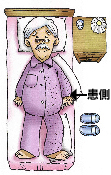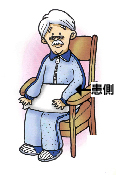Stroke: Applying Physiotherapy Principles in General Care
Caring goal
The aims of physiotherapy for stroke patients are to maintain mobility of limbs and prevent complications. Otherwise, weakness would develop in the affected limbs. In more severe cases, even increased spasticity, contracture, joint stiffness and deformity could result. It will highly hinder the limb mobility, and also increase the patient's chance of having chest infection and pressure sores. On the other hand, physiotherapy could improve patients' limb function and self care ability through appropriate rehabilitation exercises and education about proper usage of assistive devices. Complementary to the therapy itself, proper caring techniques and posture in daily living could also enhance the treatment effect.
General caring tips
1. Maintain and improve the mobility of affected limbs
- Patients are encouraged to use their affected limbs.
- Patients should do limb exercise properly according to physiotherapist's instruction.
2. Increase the awareness of affected limbs
- Try to approach the patient on the affected side during feeding, conversation or transfer. Then the patient could be assisted more effectively. Besides, it could improve the awareness for the affected limbs so as to stimulate the patient's usage of the affected limbs.
- Place daily necessities next to the affected side.
3. Prevent injury
- Use walking aids (e.g. stick, quadripod and walking frame) and wheelchair properly according to physiotherapist's instruction.
- Wear suitable footwear so as to prevent foot injury and falls.
- Avoid placing objects which are too hot, too cold or sharp near the affected side.
4. Adopt proper posture
- Adopt proper posture as the followings so as to prevent increase of spasticity.
- In lying position (Picture 1)

Picture 1- Use a firm mattress of approximately 5 cm thick to provide adequate support to the spine and the affected limbs
- Use a firm pillow with a suitable thickness so as to give good support to the neck. The head should be in horizontal alignment with the trunk and the neck should not be bent or dropped backward.
- If necessary, support the affected limbs in relaxed position with 3-4 pillows, with the elbow and fingers straightened and the knee slightly bent.
- Turn the patient into different positions every two hours if the patient cannot move on his/her own.
- In sitting position (Picture 2)

Picture2- Choose a suitable chair with backrest, arm rest and firm seat to provide good support.
- Support the affected upper limb with a pillow or armrest, with the elbow and fingers straightened.
- The depth of the seat should be appropriate so that the patient can sit straight with his/her back supported by the backrest.
- The height of the chair should be appropriate so that the patient's feet can be placed on the floor comfortably, with the hip and knee flexed at 90 degrees
5. Care of limb swelling
- If required, wear elastic stockings on the affected limbs and apply passive exercises to the limbs according to health professionals' instruction.
- Support the affected limbs in an elevated position when resting.
6. Maintain good personal hygiene
- Observe good personal hygiene.
- Keep the web spaces and joint lines of fingers and toes clean and dry in order to prevent odour and skin disease.
7. Adopt proper lifting and transferring technique
- Patients should adopt proper transferring technique to prevent worsening of spasticity of affected limbs. For example:
- Don't pull the rail of the bed to be upright from lying,
- Don't only bear weight on the unaffected leg in transferring or standing, etc
- Caregivers should assist patients, whenever necessary, by using proper lifting and transferring technique
- Hold the patient firmly without pulling the affected upper limb to avoid causing injury to the limb.
- Caregivers should maintain a proper posture by keeping close to the patients, the back straight and knees bent during the transfer process so as to prevent back injury.
Consult health professionals for advice in case of query.
Related Audiovisual and Booklet Package(s): Practical Tips - Adaptations after Stroke
